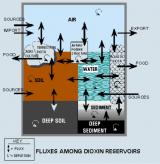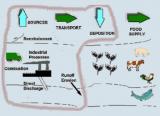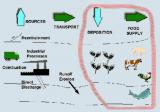Dioxin Exposure Initiative
The Dioxin Exposure Initiative (DEI) is no longer active. However, many of our web visitors have continuing interest in learning about the approach taken in the DEI, and find it useful as a repository for related DEI publications.
Objective
The DEI was identified as a multi-year effort that extended beyond the current reassessment effort; however, particular emphasis was placed on gaining as much information as possible that could be incorporated into the final reassessment. This data was critical to supporting EPA development and implementation of an agency-wide dioxin risk management strategy. The DEI was jointly funded and managed by EPA's Office of Prevention, Pesticides, and Toxic Substances (OPPT), and the Office of Research and Development (ORD).
Sources to air are dominated by the combustion of wastes and fuels. Sources to water include storm runoff, air deposition, and waste water discharges from certain industrial processes. Contributions to land include air deposition and the land spreading of waste water treatment sludge. As illustrated in Figure 1, the cycling of dioxin through the environment is a complex process, involving multiple sources, flows, reservoirs, and sinks.
- Flows include: airborne transport of dioxin vapor and dioxin contaminated particulates; water transport of dioxin contaminated suspended particulates; transport from land through wind and water erosion; transport by biota through trophic exchange; and the movement through commerce contaminated materials.
- Reservoirs include soil, sediment and manufactured materials which contain dioxins that are temporarily stored but may later be released into the circulating environment.
- Sinks represent the long-term storage and isolation of dioxin in undisturbed soil and sediment.
Although we have a general qualitative understanding of dioxin cycling in the environment, our quantitative understanding is limited.
The fundamental goal of the DEI initiative was to quantitatively link dioxin sources to general population exposure. The initiative pursued two simultaneous lines of inquiry:
- The first focused on identifying sources of dioxin-like compounds and worked forward along their pathways of transport and deposition.
- The second started with human body burdens and worked backwards through the process of bioaccumulation and uptake.
As these two lines of inquiry merged, they should provided an adequate understanding to enable EPA to target future exposure reductions efforts to those sources and pathways that most significantly contribute to human risk. An additional goal of the initiative estimated, where possible, past trends in dioxin exposure and established a current baseline for monitoring future trends.
Sources Forward
EPA adopted a strategy which divided source identification into three steps:
- source nomination,
- source confirmation, and
- source characterization.
Nomination of a source can come about based on information such as theoretical chemistry, similarity of a process to known dioxin sources, or emissions data of uncertain quality. Once a source is nominated it is then a candidate for confirmation. Confirmation is a limited monitoring or testing effort intended to confirm that dioxins are, or are not, a product of the candidate source. Confirmation testing will use conditions which are thought to be most conducive to dioxin formation. If no dioxins are found, then no further testing will be needed. If dioxins are found, then the source becomes a candidate for source characterization. Source characterization attempts to provide a basis for quantitatively estimating national emission totals for a source category. This is an inherently expensive activity and, for some sources, could absorb a major portion of the entire initiative budget; consequently, the initial focus of source identification portion of the initiative is on nomination and confirmation.
Human Exposure Backward
In its second approach, the initiative started with quantification of human body burdens, and modeled intake. This modeled intake was compared to the intake derived from newly measured levels of dioxin in the diet to see if they quantitatively confirm the diet hypothesis of exposure. The food measurements also provided a basis for determining what portions of the diet contribute most to general population exposure.
Similarly, livestock exposures were estimated on the basis of levels in animal feeds and compared with exposures derived from animal body burdens to quantitatively confirm the leaf-to-animal hypothesis. If, in the process of these studies, there are indications of additional pathways of exposure outside of the air-to-leaf-to-animal-to-human route, these will also be explored. Finally, levels in animal feeds were compared to predicted levels derived from air deposition rates to complete the linking of dioxin sources to human exposure.
Trends
The determination of past trends in emissions, depositions, and exposure could provide a more powerful context in which to develop dioxin strategies. To get a better picture of past deposition and, by inference, emissions and exposure, the DEI looked at dioxin levels in lake sediments in several regions across the United States. The DEI also used pharmacokinetic modeling to reconstruct past doses of 2,3,7,8-tetrachlorodibenzo-p-dioxin. Data collected on food and ambient air can serve as baseline measurements for tracking future trends.



